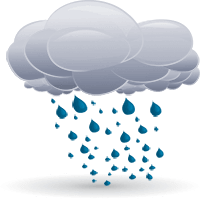Just mention the plant Kudzu and thoughts of vines choking out vegetation across the southern United States come to mind. Kudzu is a well-known invasive that fits the definition of being a non-native plant which, when introduced, flourishes and is harmful to the environment. To realize the impact of invasive plants, understanding the importance of ecosystems as well as recognizing invasive plants that are problematic in our local environment is essential.
An ecosystem is comprised of interacting species of plants, living organisms, insects, birds and animals within an environment defined by its amount of sunlight, radiation, temperature, water, chemicals, gases, wind and soil. Native plants are species that have evolved and occur naturally in an environment, and are the ecological foundation for all the other living things in that ecosystem. Plants are the base of the food chain; they provide the habitat for life forms below and above the ground. Plants recycle soil nutrients and the underground organisms which support all life on earth. The insects that thrive on native plants and the pollen and nectar these plants produce sustain butterflies, bees, hummingbirds, bats and other pollinators. Humans depend on these pollinators for the crops we eat.
In addition, native plants produce nuts, seeds and fruits essential for wildlife survival. Animals depend on plants for shelter, a place to build homes and reproduce. For example, Native Oak trees are home to 500 species of caterpillars, whereas an invasive Ginko tree only hosts five species of caterpillars. Only the biodiversity of native plants can support the various living species in an ecosystem.
Many invasive species look innocent in our yards and landscapes but wreak havoc in the wild. These plants can be spread by birds and animals dispersing their seeds and fruits. Wind, water and agricultural activities also help propagate invasive plants. Some reproduce by budding at their base or producing root sprouts. Invasive plants succeed because they are not affected by natural predators, competitors and diseases that regulate native species. On the federal list of endangered native plants, 50% are threatened due to invasives. These plants cost the United States 137 billion dollars a year by impacting crops, fisheries, forestry, ranchers and areas that involve our interaction with the environment.
Many homeowners unwittingly plant invasive shrubs or trees because they grow well and look beautiful in their yards. The genus of Ligustrum shrubs or small trees is a good example. Species include the Tree Privet, Glossy Privet, Chinese Privet and Wax Leaf Ligustrum. These shrubs can grow up to 25 feet tall and take over a forest if not controlled. They are not a natural habitat for birds or animals; rather their berries and leaves are toxic to insects, animals and humans. Another bush commonly grown in Central Texas is the Nandina. Its berries contain cyanide and other alkaloids poisonous to all animals. When spread to the wild, the insect and bird populations decrease.
Three species of trees — Chinese Tallow, Chinaberry Tree and Chinese Pistache — are on the invasive list. Their leaves contain toxins that raise the soil pH and negatively alter the soil for other native plants. They do not provide habitat for wildlife or forage areas for livestock. Other invasive trees include Mimosa, Princess Tree, Paper Mulberry, Tree-of Heaven and Salt Cedar.
Fast-growing and self-propagating Elephant Ears can spread to wetland areas and form dense growth overtaking all native species. They are poisonous to animals and their leaves can cause skin irritation. In contrast, native plants in a wetland slow water movement, allowing it to reach deep into the soil and recharge aquifers. These plants protect us from flooding and rising sea levels.
This year’s proliferation of Bastard Cabbage was visible in most of our roadside fields. This small-to-medium bush covered with yellow flowers replaced many of our Texas wildflowers. It will cover agricultural fields, roadsides, open forests and streams, preventing native species from thriving. Two other particularly nasty invasives are the Yellow Star Thistle and Malta Star Thistle. Their heads have long, thorny flowers, and like the Bastard Cabbage, they crowd out our native wildflowers by taking up sunlight, water and soil.
While this does not cover all the invasive species taking up residence in Central Texas, it should get homeowners thinking of their part in keeping our wild habitats and environments safe for the plants and wildlife that we enjoy and depend upon. For more information on invasive plants in Texas and how to control them, contact the Texas A&M Agrilife Extension Office for Hays County (512-393-2120) or visit texasinvasives. org or npsot.org.



